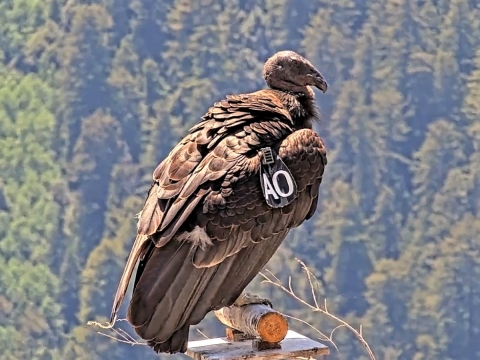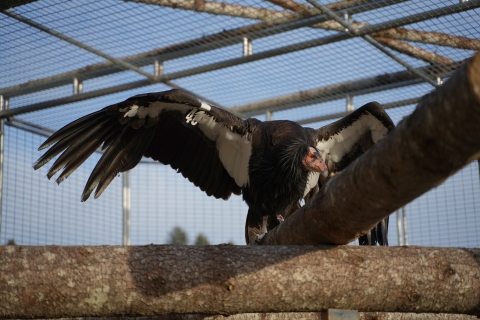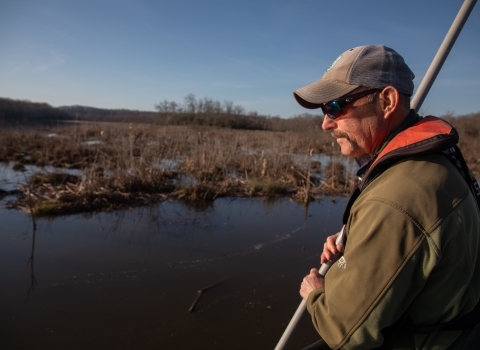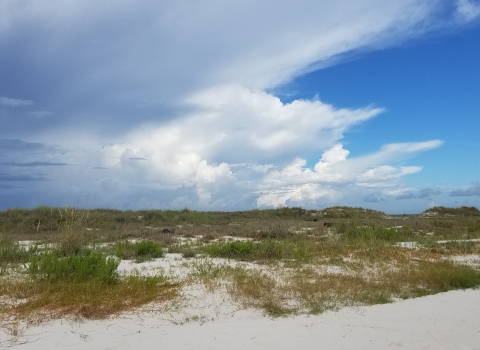For the first time in more than a century, endangered Prey-go-neesh (California condors) can now be seen flying over Northern California’s redwoods.
On May 3, 2022, the Yurok Tribe successfully released the first pair of condors, out of a group of four, in Redwood National and State Parks, establishing the northernmost condor release area to date, and reclaiming a significant part of their former historic range, from which they’ve been absent since 1892.
“This journey towards restoration began in 2003, when a panel of Yurok elders made the decision that Prey-go-neesh was the highest priority land-based animal to return to Yurok ancestral territory due to the Yurok’s deep cultural connection to the birds,” said Yurok Wildlife Department Director Tiana Williams-Claussen.
The reintroduction effort builds on over a decade’s worth of planning and preparation initiated by the Yurok Tribe with support by the U.S. Fish and Wildlife Service, the National Park Service, State and other partners.
“For countless generations, the Yurok people have upheld a sacred responsibility to maintain balance in the natural world,” said Joseph L. James, the Chairman of the Yurok Tribe, in the days leading up to release. “Condor reintroduction is a real-life manifestation of our cultural commitment to restore and protect the planet for future generations. It is a historical moment in the Yurok Tribe, as we introduce our condors back home, providing that balance for us. Our prayers are answered.”
The four condors, including one female and three males, are between two and four years old, an ideal age range where they would leave the care of their parents in the wild. Although it will take several years until these birds are at an age to reproduce in the wild, we believe we have a model for success with future northern reintroduction efforts. Learn a little more about each condor below.
Poy’-we-son (Wing tag A3)
Hatched: Peregrine Fund’s World Center for Birds of Prey
Age: 2-year-old male
About me: First out the holding pen, we have Poy’-we-son, which literallytranslates to, “the one who goes ahead,” but also harks back to the traditional name for a headman of a village, who helps lead and guide the village in a good way.
“A3 is one of the more dominant birds, and I expect that he’ll be a leader amongst this flock and for new birds coming in,” said Williams-Claussen.
True to his name, Poy’-we-son was adventurous right from the start, boldly exploring the area surrounding the release facility for two weeks before returning to the release enclosures. His sojourn will have equipped him with valuable knowledge which he will share with his fellow cohort-members, as the small flock expands across the landscape.
Studbook number: 1045
Nes-kwe-chokw’ (Wing tag A2)
Hatched: Oregon Zoo
Age: 2 1/2-year-old male
About me: “Nes-kwe-chokw,’ which translates to ‘He returns’ or ‘He arrives,’ is a representative of the historic moment we just underwent, and condors’ return, free-flying, to the Yurok and surrounding landscape,” said Williams-Claussen. “He is a confident bird, often jockeying with A3 in play, but also to help establish his place in the hierarchy and with the will to do well in the wild.”
Also proving true to his nickname, Nes-kwe-chokw’ initially has stuck more closely to “home,” the release enclosure, seemingly awaiting the release of the rest of his flock. Though growing increasingly comfortable ranging farther from the release facility, he has largely shown himself content to stay close to the facility, visiting with the birds remaining in captivity and agreeably taking advantage of food proffered by biologists to keep the far-ranging birds interested in the facility, which will be used for ongoing management.
Studbook number: 1010
Ney-gem’ ‘Ne-chweenkah (Wing tag A0)
Hatched: Oregon Zoo
Age: 3-year-old female
About me: Ney-gem’ ‘Ne-chweenkah’ which translates to “She carries our prayers” is the only female of the first released cohort. “She represents the creative life-force energy that females bring to the world,” said Williams-Claussen. “It’s powerful. I envision her as the start of a whole new life and possibilities, both for our flock and for condors throughout their range. We also imbue this name with our prayers for her specifically, her cohort brothers and for all condors. She carries those, wherever she goes. We are incredibly grateful that Prey-go-neesh have come home to carry our beliefs, our energy, and our prayers when we’re asking for the world to be in balance, as a critical part of ecological community.”
Though she struggled a bit with the mechanics of flying free in her first forays, as her first time to spread her wings in the wild, she’ll figure it out soon and has integrated well with both Poy’-we-son (A3) and Nes-kwe-chokw’ (A2). All three are comfortably sharing resources and will continue to learn from and teach each other.
Studbook number: 969
Hlow Hoo-let (Wing tag A1)
Hatched: Peregrine Fund’s World Center for Birds of Prey
Age: 3-year-old male
About me: “A1 has been nicknamed ‘Hlow Hoo-let’ which means ‘At last I (or we) fly!’ In line with the heavier names this first cohort carries,” said Williams-Claussen. “I interpret that as reference to the joyous day that all four of our first cohort fly free together.
On a lighter note, it's definitely also a reference to poor A1's extended wait to be let out, due to his faulty transmitter! We welcome Hlow Hoo-let to the skies of Yurok and surrounding lands, and look forward to his journey with us.”
On July 14, 2022, he was the last to join the cohort with his friends, who together will take flight toward reestablishing a California condor population in the Pacific Northwest.
Studbook number: 973
Paaytoqin - Mentor bird (Condor 746)
Hatched: Peregrine Fund’s World Center for Birds of Prey
Age: 8-year-old male
About me: “His name Paaytoqin (pie-toe-quin) means ‘come back’ in Nez Perce language because he returned to World Center Birds of Prey, one of the recovery program’s captive breeding facilities, after being at Oregon Zoo for three years,” said Leah Esquivel from the Peregrine Fund.
Hatched in 2014, he was selected to be held back for captivity based on genetics and is unreleasable.
“We do not release captive adults that have never had any wild experience,” said Steve Kirkland, California condor field coordinator for the U.S. Fish and Wildlife Service. “He could be paired with a mate in the future, if necessary; however, as for now, his role as a mentor will be an important influence on the younger birds.”
Paaytoqin was chosen as a mentor bird because of his calm nature and good disposition. Prior to arriving to the Northern California Condor Reintroduction Program Facility, he proved to be a steady and centering influence on young birds, helping them become acclimated to their new region and with their development of critical social behavior before their release. He regularly charges turkey vultures outside of the pen feeding, showing the condors stature in the feeding order.
“He will eventually return to captivity to help contribute to the health and vitality of the overall flock as part of the captive breeding program after his stint in Northern California,” said Williams-Claussen.
Comprised of biologists and technicians from the Yurok Tribe and Redwood National Park, the Northern California Condor Restoration Program will collaboratively manage this flock from a newly constructed condor release and management facility in Northern California, near the Klamath River in Redwoods National and State Park.
“The return of the condors to the skies over the Redwoods represents a significant milestone in the restoration of this magnificent forest to its former glory,” remarked Redwood National and State Park Superintendent Steve Mietz. “This project is a model for listening to and following the lead of the park’s original stewards, healing both our relationship with the land and its original people.”
With the release of these birds, the Northern California Condor Restoration Program team officially joins the larger California Condor Recovery Program led by the U.S. Fish and Wildlife Service. The recovery efforts include three additional release sites in California, one in Arizona and one in Baja Mexico. Each release site is championed by a partner in condor recovery.
“The reintroduction of condors into Northern California is truly a monumental moment,” said Paul Souza, Regional Director for U.S. Fish and Wildlife Service’s Pacific Southwest Region. “This effort builds upon the program’s collective knowledge and history of releasing condors and showcases the benefit of partnering with tribes and others to implement recovery of listed species. We are proud to support this collaborative and innovative partnership with the Yurok Tribe and Redwood National Park. Together we can recover listed species for future generations.”
“PREY-GO-NEESH KEECH KE-ME’-YEHL – CONDORS HAVE COME HOME.” – The Yurok Tribe
For more information, please visit:
https://www.fws.gov/program/california-condor-recovery
https://www.yuroktribe.org/wildlife
Note: links do not imply endorsement (see: https://www.fws.gov/disclaimer for more information).












